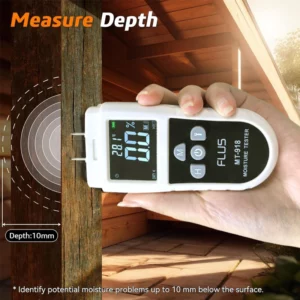When it comes to burning firewood, one of the most important factors is its moisture content. Wet firewood is not only harder to light, but it also burns inefficiently, producing less heat and more smoke. This is why using a moisture meter, or specifically a firewood humidity meter, can make all the difference in ensuring your firewood is ready for burning. But is a firewood humidity meter really that useful?
A firewood humidity meter is a tool designed to measure the moisture content of firewood. It works by using either electrical resistance (in the case of pin-type meters) or electromagnetic signals (in the case of pinless meters) to determine how much moisture is present in the wood. The higher the moisture content, the harder the wood is to burn. Ideally, firewood should have a moisture content of around 20% or lower for efficient burning.

Burning wood that is too wet can have several negative consequences. Here are a few reasons why moisture matters:
- Efficiency: Wet wood burns inefficiently, which means you need more wood to produce the same amount of heat. This also leads to a larger amount of smoke, which can be a nuisance, especially if you’re burning in a fireplace or wood stove.
- Creosote Buildup: When burning wet wood, the combustion process is incomplete. This can result in a greater buildup of creosote in your chimney or stove pipe, which is highly flammable and can lead to dangerous chimney fires.
- Environmental Impact: Burning wood with high moisture content also contributes to more air pollution, releasing more particulate matter and other pollutants into the atmosphere. Dry wood is more eco-friendly and burns cleaner.
Given these drawbacks, having an accurate way to measure the moisture content of your firewood is incredibly important. This is where a firewood humidity meter comes into play.
If you’re still wondering if a firewood humidity meter is useful, consider the following benefits:
- Accurate Readings: A firewood humidity meter provides precise readings that help you determine whether your wood is dry enough to burn. Wood with too much moisture will show a high reading on the meter, while dry wood will show a low reading.
- Save Time and Effort: Without a firewood humidity meter, you might rely on outdated methods like checking if the wood “feels dry” or “sounds hollow” when struck. These methods can be unreliable and time-consuming. A firewood humidity meter saves you the hassle and gives you fast, accurate information.
- Better Burning Experience: When you know that your firewood is at the ideal moisture level (around 20%), you’ll enjoy a cleaner, hotter burn. This means fewer logs, less smoke, and less work on your part to keep the fire going.
- Cost-Effective: Although a firewood humidity meter is an investment, it can actually save you money in the long run. By ensuring that you only burn dry wood, you’ll use less firewood overall, and you’ll also avoid the extra costs associated with chimney cleaning due to creosote buildup.
Conclusion
In conclusion, using a firewood humidity meter is an excellent way to ensure that your firewood is dry enough to burn efficiently. Whether you’re an occasional user or rely heavily on firewood for heating, a firewood humidity meter can save you time, reduce waste, and make your burning experience cleaner and more efficient. Don’t rely on guesswork – invest in a FLUS firewood humidity meter and make sure your wood is ready to burn when you need it most.
